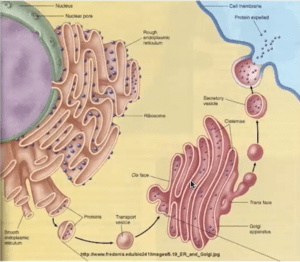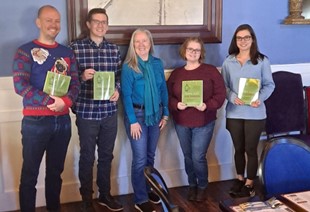A group of AP STEM teachers from across Indiana used the Question Formulation Technique (QFT) to build the skill of asking questions alongside subject-specific learning in multiple areas of science. Below, you can explore how they used the QFT for AP coursework in chemistry, environmental science, physics, and biology
The group is part of the Advanced Placement Teacher Investment Program (AP-TIP), housed at the Center for STEM Education at the University of Notre Dame. The center strives to bring high quality STEM education to all young people, especially those in underserved communities.
Every year, AP-TIP enrolls a cohort of AP teachers, and the program provides professional development opportunities throughout the year to support AP coursework in schools.
The Right Question Institute presented at AP-TIP’s fall conference in 2022, and in 2023 the program’s science support team — consisting of Maureen McGrail, Kevin Morse, Melissa Burger, Jacob Bowman, and Kristi Phillippe — chose Make Just One Change, by RQI co-founders Dan Rothstein and Luz Santana, as the book to study for the year. They each piloted the QFT process in their classrooms and created a series of short video presentations to showcase their work.
Here are their classroom examples, and you can also watch their video presentations to learn more.
AP Chemistry (VIDEO)
Kevin Morse is an AP chemistry teacher who’s been using the QFT for about a year. He started by using it to introduce several unit topics, such as equilibrium and reversible reactions (using a demo showing the equilibrium principle in action) and thermodynamics (using the prompt “Diamonds are NOT forever” accompanied by the reaction equation of diamond breaking down into graphite). He likes the QFT best for unit introductions, transitions, or for topics he wants students to think deeper about, and he often uses QFT in connection with the demonstrations he does in class.
Morse’s students have already taken an intro chemistry course at some point before joining his AP class, so the concepts aren’t entirely new, just taught with more complexity. He says the idea with using the QFT for these old-but-new topics is, “You’ve seen things like this before, what do you need to know to understand it?” Using the QFT is about “taking the skills they already have, and building on them, and getting the student out of the habit of just doing what we’re telling them to do, in the way we’re telling them to do it.”
Chemistry QFT Example from Kevin Morse’s Class:
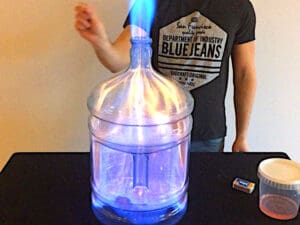
AP Environmental Science (VIDEO)
Melissa Burger, an AP environmental science teacher, starts her first QFT of the year by asking students, “Why is it important to be able to ask questions?” At first, her students say “to get the right answer.” However, with a little more time to think about it, they start to think about scenarios in which being able to ask good questions would be helpful. They mention times when something is new to them, or stressful. One students says, “when I buy my first new car.” Another mentions when their mind goes blank at the end of a job interview. Burger’s takeaway from this conversation is that “it is important to give students a reason why” when asking them to engage in the QFT.
Burger’s early QFTs gave students a statement to ponder. In Unit 2 of the AP Environmental Science curriculum (in which students learn about the biodiversity within ecosystems), Burger gives the QFocus: “Ecosystems can recover from disturbances in many different ways.” Students wondered about what types of disturbances were occurring, why different ecosystems may respond differently, and what sorts of things are different about ecosystems. In Unit 6 (Energy Resources and Consumption), Burger used a slightly more provocative statement, which inspired even more questions: “America NEEDS to change the way it produces energy.” Students asked, Why do we need to change? How could we change? Who says we need to change? Ultimately, Burger’s favorite QFT was one that centered around a set of data, which you can read more about below.
Environmental Science QFT Example from Melissa Burger’s Class:

AP Physics (VIDEO)
Jacob Bowman’s go-to QFocus is very simple: He holds a tennis ball and racquet ball out at the same height and has students watch what happens as he drops them. Before doing this, each student is given a sheet of computer paper. This part of the QFT is very quiet as students are observing what happens and writing down their questions. Bowman repeats the ball drop demonstration a few times so that students have ample time to form observations and write questions. He reminds them that whatever they think to ask is okay, as long as it is related to the QFocus and is a question. As he sees students slowing down with their questions, he encourages them to try to write at least one more.
Physics QFT Example from Jacob Bowman’s Class:
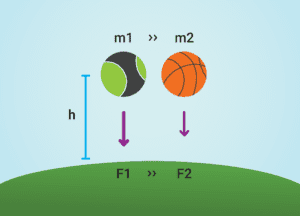
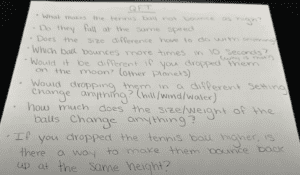 Small Group Questions
Small Group Questions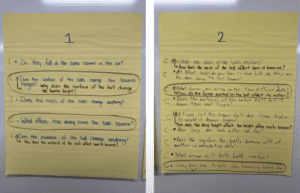 Whole Class Questions
Whole Class Questions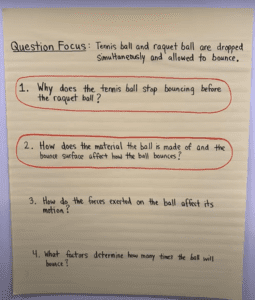
AP Biology (VIDEO)
Kristi Phillippe saw a statistic from Edutopia that said students who studied a lesson and then wrote their own questions outperformed students who simply restudied — by 33% on a follow up test. That was her initial motivation to invest in the QFT with her students. From there, she started giving students diagrams — of the endomembrane system, the ATP cycle, photosynthesis, and more — as QFocus prompts. She wanted students to see the whole process and all the associated vocabulary before they learned the material so that they could start to build background knowledge that would help them better digest and internalize the concepts later. Background knowledge is an important concept connected to disciplinary literacy that involves providing students with key material, concepts, and vocabulary before teaching a skill or concept. It is distinct from prior knowledge (which is the knowledge students already have from past experiences). As she did the QFT more and more with students, she saw them start to successfully use new vocabulary to talk about concepts they hadn’t learned yet, and be better able to see the whole picture and understand the underlying purpose behind these life science processes.
Biology QFT Example from Kristi Phillippe’s Class:
